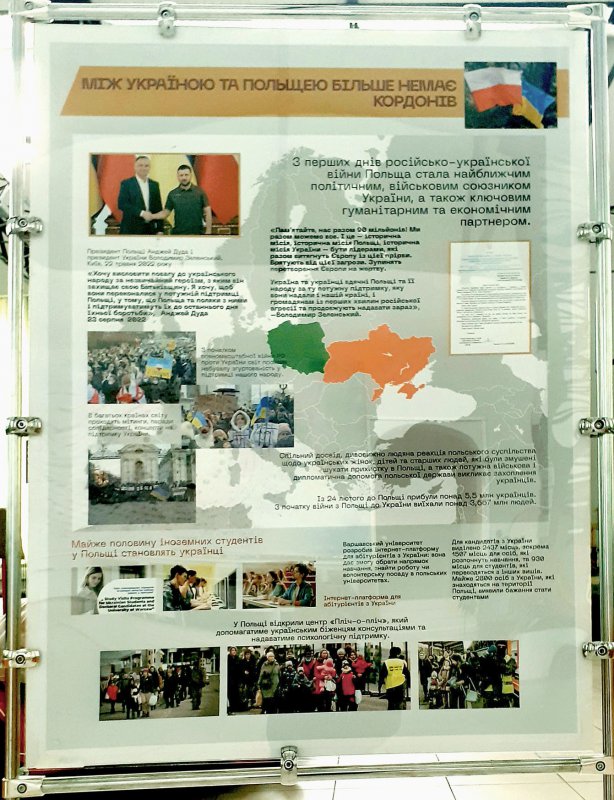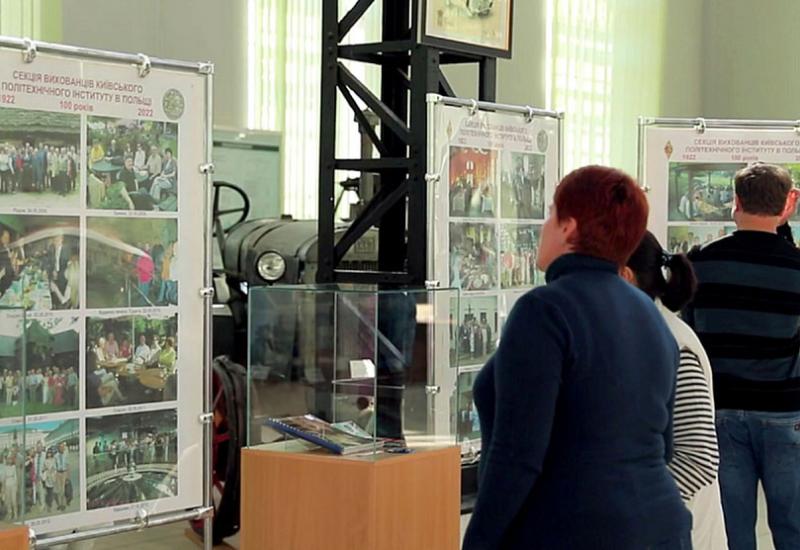The war unleashed by russia against our country finally clarified who is Ukraine's bitter enemy and who is its true friend. And among the closest and most faithful friends is Poland, which has sheltered millions (!) of our compatriots and constantly helps our country both with the supply of modern weapons and with the provision of many things that greatly facilitate the life of Ukrainians today. Relations between our peoples date back to ancient times, and although they were not always completely cloudless, today's trials prove that the concept of "brotherhood of nations" is not an empty sound for Poles.
The materials of one of the stands of the exhibition dedicated to the 100th anniversary of the Section of Alumni of Igor Sikorsky Kyiv Polytechnic Institute in Poland opened at the Borys Paton State Polytechnic Museum at Igor Sikorsky Kyiv Polytechnic Institute on October 4, speak volumes about that. The stand is called "No more borders between Ukraine and Poland", and it contains materials about the friendly support that Poland provides to Ukraine throughout all the months of this bloody war.
In fact, all the exhibits of this exhibition illustrate the history of friendly relations between our countries and peoples, shown through the lens of the centennial activity of the association of alumni of Kyiv Polytechnic Institute working and living in Poland. You can see quite a lot of interesting things at the exhibition. They allow not only to get a closer look at some little-known chapters of our university’s history, but also to learn about prominent Polish scientists and statesmen who once graduated from Kyiv Polytechnic Institute; and even to better understand certain processes that took place in Poland at the beginning and in the middle of the 20th century and allowed the Poles to escape from russia’s imperial grasp much faster than us. Look no further than the fact that the Poles consider 1915 to be the year of the real birth of the university in their capital – when teaching was completely switched to the Polish language, despite Tsar Nicholas II signed the decrees on the creation of the Kyiv Polytechnic Institute and the Warsaw University of Technology at the same time in 1898, as exhibition curator Lubov Bakaeva says.

First of all, of course, the materials of the exhibition make it possible to learn about how and thanks to whom generations of Polish colleagues managed to remain loyal to their alma mater and stick to each other despite the years and sometimes rather unfavorable circumstances for a whole century. According to Lubov Bakaeva, more than 300 Poles graduated from Kyiv Polytechnic Institute before 1920, and just as many graduated after World War II. Quite a few graduates occupied very important positions in their country, and some touched the heights of science. A separate stand is dedicated to them at the exhibition. Some of their names are definitely well known to us, for example, the name of the outstanding Polish physicist and chemist Wojciech Swientoslawski, whose monument is installed near the university building 4 (by the way, it was he who initiated the creation of a Circle of Alumni of Kyiv Polytechnic Institute in Poland a hundred years ago). However, you can make real discoveries for yourself here. Especially about people whose names seem familiar to those who are interested in history. Let's say, did you know that a graduate of the chemical department of the Kyiv Polytechnic Institute, later a well-known Ukrainian public figure and politician, minister in the governments of the Ukrainian People's Republic and the Directorate, Ivan Feschenko-Chopivsky was a professor at the Warsaw University of Technology from 1922, and later, until his arrest by the NKVD in 1945, headed the department at the Krakow Mining and Metallurgical Academy?
The photo of the participants of the congress of the Section of Alumni of Igor Sikorsky Kyiv Polytechnic Institute in Poland taken in 1938 and exhibited on one of the stands is impressive: there were really a lot of them. Some statistical data on the education of young Polish citizens at Kyiv Polytechnic Institute in different years also attract attention. By the way, our university (more precisely, then the institute) was awarded the Commandery of the Order of Merit of the People's Republic of Poland for a significant contribution to the training of specialists for Poland in 1984. The Order can also be seen at the exhibition.
And, of course, the exhibits about the student life of Kyiv Polytechnic Institute in the fifties of the last century are very interesting. They were provided by Janusz Fuksa, a graduate of Kyiv Polytechnic Institute in 1959, the permanent head of the Section since 1974, Doctor Honoris Causa of Igor Sikorsky Kyiv Polytechnic Institute and a great friend of our university and many of its employees and lecturers. He saved not only photos of the university of his years of study, and his group, but even his own dormitory pass, which is now a real historical artifact!
In general, Janusz Fuksa provided enormous help to the organizers of the exhibition. For example, he helped a lot in choosing the personalities of famous graduates to present them in the museum hall. "It was Janusz Fuksa who chose and sent us the biographies of 14 of the most outstanding graduates of Kyiv Polytechnic Institute who graduated in the first decades of the 20th century. There could be many more of them, but the area of our stands is limited," Lubov Bakaeva explains.
The exhibition will be open until the end of the year, so there is still time to visit it. And it is really worth visiting.
An Exhibition That Is Worth Visiting
Borys Paton State Polytechnic Museum at Igor Sikorsky Kyiv Polytechnic Institute presented a unique exhibition.
It presents the Polish pages of the history of the Kyiv Polytechnic Institute. The exposition will be available to visitors until the end of 2022.

